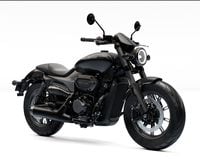In technical terms, the job of a threaded fastener is to apply a comprehensive force to a connection, creating a joint strong enough to oppose any static, tensile, and dynamic loads that may be placed upon it. By that same token, the fastener(s) used must also be capable of resisting impact, shock, vibration, shear, bend, torque and vector (angular) forces, as well as other compressive loads. Boil away the jargon and it means that bolts work by clamping things together under tension and that both the connection and the bolt must be strong enough resist any force that tries to break that connection or the bolt that’s holding it together.
Before we go much further let me point out that while there are formal definitions that distinguish bolts from screws, it’s a lot easier (and just as cor- rect in an informal setting) to use either term to describe threaded fasteners, so unless we need to identify a particular type of fastener, such as sheet metal screw or Allen head bolt, we’ll use the terms screw and bolt interchangeably.
How Bolts Work
Steel, no matter what its composition, is elastic, and when a load is applied to it in tension, it stretches; like any other spring, the further it's stretched, the more it resists. Think of bolts as very stiff springs, and you'll have the gist of it.
Picture two steel plates, held together by a nut and bolt. Turning the nut advances it along the threads of the bolt, which creates tension on the portion of the bolt that passes through the joint, stretching it slightly. The more torque we apply to the nut, the further the bolt stretches, and the harder it tries to return to its relaxed state. As the bolt stretches a compressive load is placed on the joint, binding it together. That compressive load is directly proportional to the distance the bolt is stretched, which itself is dependent on how tight we can make the nut. In a nutshell, that’s how bolts work, and you can now understand why it’s so important to properly torque fasteners. Unless a screw is placed under the proper tension, it won’t be stretched far enough to secure the connection; in effect, it’ll be like any other slack spring—too relaxed to do its job.
Of course, a bolt can only be stretched so far. Exceed that limit, and it’ll reach its “Yield Point,” which is the stage at which it can no longer return to its original length when the load is removed. Once a bolt has reached the yield point, any further tightening will stretch it beyond its tensile limit, so it’ll have considerably less clamping power and be more likely to loosen or break in service. A bolt that has reached its yield point will have a “necked” or dog bone appearance to it, and is unsafe to use under any circumstances.
Identifying Common Hardware
Fasteners are identified by type, dimension and physical properties, so some understanding of the nomenclature is always handy. This is particularly true if you need to replace a bolt in an emergency, or for example want to replace one type of bolt with another for appearance or convenience sake.
understand that in some instances a given application may require specialized hardware, so while replacing a luggage rack fastener with a generic bolt from the local True-Value store is perfectly acceptable, the same can't be said if you're replacing something like a dished head UBS-style motor mount bolt with a hunk of threaded rod.
Types of Fasteners
Hex-Headed Bolts:
As the name implies, the head of the bolt incorporates hexagonal flats to accommodate a wrench or socket. Technically speaking, bolts are always tightened by a nut. When they're threaded into tapped holes, they're sometimes referred to as cap screws.
Flanged Bolts:
These have a flare resembling a small washer machined into them. These are often used to hold things like engine side covers in place, and have largely replaced Phillips head screws in that role because they are less susceptible to damage during installation and removal. Larger sizes are used when it's desirable not to use a separate washer.
Allen or Socket Head Bolts:
Allens use internal hexes, which facilitate installation and removal; both button and countersunk versions are available.
Torx:
Torx-style bolts use a unique 6-point hex-globe shape to engage the tool. The drive may be internal, in which case it's called a T-type, or external, the E-type. A variation of the design uses a small projection, which requires a dedicated tool. These are known as tamper-proof and are used to prevent people from adjusting things they shouldn't, like throttle position sensors.
Phillips-Head Screws:
These used to be the bane of every mechanic. Most of us are familiar with these cross-slotted screws, and I daresay we've all stripped our fair share of them. They're no longer very popular and that's a good thing.
Studs:
Studs are pieces of threaded rod without hexes that are screwed into a component; a nut is then used to hold something to it. Very often studs are used to clamp things like cylinders to cases or heads to cylinders.
Besides the common fasteners, motorcycles use a fair amount of dedicated hardware. For example, there’s the DR or dish-headed bolt, which is a flanged headed bolt with weight reduction holes drilled into it, and UBS bolts, which are undercut flange bolts designed to resist loosening. These bolts and others require unique torque settings so always consult the shop manual when you encounter them.
Nuts and Washers
Nuts work in conjunction with bolts and also come in a variety of types.
Plain Nuts:
Used to secure the ends of bolts, screws, and studs.
Self-Locking Nuts:
Sometimes called "air craft or Ny-Lock nuts," these nuts use plastic inserts that grip the bolt thread
to prevent loosening. Because the plastic is deformed in use, these should never be reused.
Prevailing Torque Nuts:
Also called "stiff nuts," these are made to deform once they've been torqued. In some cases, they're reusable, though my preference is to replace them.
Spring Nuts:
A type of self-locking nut that uses a small locking spring to hold it in place. Provided these are properly removed, they can be reused.
Castellated Nuts:
The castellated nut has small projections machined into it, so that it resembles a castle turret. After it's been torqued, a cotter pin can be pushed through it to lock the nut to the shaft, which has an accommodating hole drilled through it. Castellated nuts are commonly found on axles, and while the nut is reusable, the cotter pin should always be replaced.
Some applications will also use things like dome nuts, either to seal the bolt or to provide decoration, and flange nuts, which, like the flange bolt, allows you to omit washers. There are also some applications that call for hardened nuts, but generally speaking, those are unique to their application.
Decoding the Nomenclature
Places that sell hardware rarely have bins marked "bolts about this long and I dunno, maybe that big around," so unless you're going to order every piece of hardware you'll ever need directly from the OEM, you'll need to know exactly what it means when a bolt is described by dimension and class. Let's start with a common bolt described as an 8 X 1.25 X 30.
The first number represents the bolt’s size, which is determined by the bolt’s threaded diameter and not, as some people think, by the size of the wrench that fits across the bolt’s flats. That being said, when it comes to common hardware, the size of the flats will provide an indication of the bolt’s size, as the distance across the flats is generally (though not always) standardized.
The thread pitch is the next thing you need to know. A bolt’s pitch represents the distance between its threads, and the bottom line is that most common bolts are available in either fine or coarse pitch. You also need to know that the pitches are not interchangeable. Trying to force a coarse thread onto fine one will ruin both in short order. if you’re not sure if the pitch is the same, trial-fit the bolt by hand or if you plan to do a lot wholesale nut and bolt replacing, invest in a thread gauge.
The last number represents the bolt’s length as measured from the underside of its head to tips of the thread. In this example, we have an 8mm diameter bolt with a 1.25 pitch that’s 30mm long.
Dimensionally, that’s all we need, but there’s one more thing we need to know, and that’s the bolt’s strength grade, or property class.
A bolt’s property class (metric) or strength grade (SAE/fractional) is an indicator, among other things, of how much tension it can bear before reaching its yield point. If we know what grade of bolt we have, we know how strong it is, and how much torque we can safely apply to it.
Fortunately, the class designation is stamped on the heads of most bolts. In most metric applications, numbers will be stamped in the bolt’s head. 12.9 is the strongest bolt, and 4.6 the weakest, though some special application bolts may use a symbol that designates a specific torque. SAE bolts will use a series of slashes; the more slashes the stronger the bolt.
The problem here is that not all bolts are marked, which can make replacing missing or unstamped ones difficult. let me digress here and point out that unless you know differently, you should always assume that an unmarked bolt is in the weakest class.
However, if you know the recommended torque of the bolt, you can make a reasonable assumption as to its grade. For example, an 8mm bolt, carrying the property class designation 8.8, has a suggested recommended torque of 19 ft-lbs, while the same size bolt in the 12.9 property class can safely handle 37 ft-lbs. if the shop manual recommends tightening a particular 8mm bolt to 35 ft-lbs, you can infer that you’ll need a 12.9 rated bolt to suit the application. That’s all well and good until a bolt goes missing on the road. If the bolt is in a low-stress application, then just about anything will do. However, if it appears to serve a critical role, buy the highest grade you can find, tighten it securely and keep your eye on it until you can determine the correct grade and torque setting of the bolt.
Proper Installation Techniques
Unless the bolts are tight, our motorcycles are just a large collection of parts flying in loose formation, so the first order of business is to check them on a regular basis. This doesn't have to be a big deal; whenever I change the oil on my bike I spend a few minutes wandering around the thing with a handful of wrenches, tugging on all the nuts and bolts.
If anything of consequence is found, you’ll need to remove the bolt and inspect it for damage, especially necking. If any is found, replace the bolt; if none is apparent, you can reuse the bolt, but in either case it should be torqued to the manufacturer’s spec. Minor hardware can simply be retightened. Ask ten mechanics how to tighten a screw and you’re likely to get ten different answers. Here’s the method I use, but as always you should defer to the equipment manufacturer’s instructions or the bike’s shop manual should any questions arise.
I like to lubricate my bolts before installing them. The lubricant protects them from corrosion, prevents galling, and makes them easier to remove at a later date. However, many torque specifications assume the bolt is dry. If a dry spec is given, reduce the torque setting by 20 percent (some manufacturers recommend 50 percent). Don’t worry, the bolt won’t loosen—in fact a lightly oiled bolt, due to the lowered friction incurred during the tightening process, generally provides more clamping power at a lower torque than a dry one at the specified torque.
I also prefer to use a hardened flat washer under the bolt head and nut where applicable. This is a contentious subject. Proponents point out that a flat washer distributes the load more evenly, provides a more consistent surface for the nut and bolt to rotate against as they’re being torqued, and prevents the nut and bolt head from embedding themselves in the work piece. The non-washer camp points out that if a washer rotates while you’re tightening the bolt, you’ll get a false torque reading, and that if it’s improperly installed (see Tech Tips below) it may cause the bolt to shear.
As I said, I think the benefits of washers outweigh any potential problems, so unless there are instructions to the contrary I use them. When you’re working with a nut and bolt, I recommend tightening the nut against the bolt whenever possible. My reasoning is twofold. First, most printed torque values apply to tightening the nut, not the bolt, and secondly, when you torque a bolt, some twist occurs in its body. When you release the wrench and the bolt relaxes, it decreases the preload. Whether it’s enough to affect the connection is debatable, but when I have to torque a bolt against a nut, I increase the torque by 20 percent.
Lastly, I can’t stress the importance of using a torque wrench. As I’ve said, a bolt has to be stretched to work properly; under-tightening fails to stretch it enough, and over tightening stretches it too far. So anytime a critical fastener is installed, a torque wrench should be used.
As a final thought, consider this; despite all our modern advances, we’re still using a technology that was well understood in the 3rd century BC. I’d bet money I don’t have that when that very last bike is assembled, it’ll still be that same technology.
What's with Washers?
Flat steel washers are flat steel washers right? Well, not exactly. First, flat washers come in various sizes, fits and styles, so a 6mm machine washer is a very different thing from a 6mm fender washer. Fortunately, in most instances, the type of washer required will be self-evident, or you can use an old one as a guide toward replacement. If you enjoy learning such things, you may want to check out some of the online tutorials or pay a visit to your local industrial supply house.
In the meantime, here are a few tips. Metal washers are stamped from sheets, and accordingly have a smooth and a coarse side to them. The smooth side of the washers ID has chamfer to it, which is intended to protect the fillet area of the bolt. Consequently, flat washers should always be installed with their smooth side facing the head of the bolt; this prevents the washer from digging into the fillet of the bolt and causing stress risers, which conceivably might cause the bolt to fail under stress.
Secondly, washers are rated as being hard or soft. Soft washers have their place, but it’s not on a motorcycle. Soft washers tend to bow, which reduces the tension on the bolt, allowing it to loosen, and in a worst case, collapse enough to dig into the bolt and saw through it. Hard washers should always be used, and this is particularly true when any bolt above SAE grade 5 or metric 8.8 is used.
Finally, there is some disagreement among hardware engineers over whether washers are required. I prefer to use them because they spread the bolt head load more evenly, prevent the nut or bolt from embedding themselves in the material, and protect finished surfaces from marring. You may not feel that way, but in any case, if the manufacturer saw fit to use them I’d suggest you continue to do so.










/cloudfront-us-east-1.images.arcpublishing.com/octane/KSFOD4JSK7X7JISPNAGJDIQHQU.jpg)
/cloudfront-us-east-1.images.arcpublishing.com/octane/TPYKJU6GGPXD7LKVMXK3VUIKPA.jpg)
/cloudfront-us-east-1.images.arcpublishing.com/octane/2H5SYCDCKONA3ENN22MKTQ4FMQ.jpg)
/cloudfront-us-east-1.images.arcpublishing.com/octane/75S6SIUC6BPRSCMSI6JN4ZQUJ4.jpg)
/cloudfront-us-east-1.images.arcpublishing.com/octane/5AALEWSTR5AGG5IBSIZM46AQDE.jpg)
/cloudfront-us-east-1.images.arcpublishing.com/octane/FUSHP3IXVCDFDZ7GPGDRFWEG5A.jpg)
/cloudfront-us-east-1.images.arcpublishing.com/octane/GNS676BUWWBSHLZ5WC2AA33QH4.jpg)
/cloudfront-us-east-1.images.arcpublishing.com/octane/4XPBZKWIXH3OVSFK4KGQ3ISEXU.jpg)
/cloudfront-us-east-1.images.arcpublishing.com/octane/YS6M2TE7BU5ORJ35FV7PMJP3HY.jpg)

/cloudfront-us-east-1.images.arcpublishing.com/octane/6KKT5NNL2JAVBOXMZYS5ZO76YA.jpg)
/cloudfront-us-east-1.images.arcpublishing.com/octane/H6Z2IC7WYRBXZNQS4MI3SZ5KPQ.jpg)
/cloudfront-us-east-1.images.arcpublishing.com/octane/IWO5T5PBT5E4HFQ5GK47H5YXR4.jpg)
/cloudfront-us-east-1.images.arcpublishing.com/octane/OQVCJOABCFC5NBEF2KIGRCV3XA.jpg)
/cloudfront-us-east-1.images.arcpublishing.com/octane/F3O2DGLA4ZBDJGNVV6T2IUTWK4.jpg)
/cloudfront-us-east-1.images.arcpublishing.com/octane/ZXYQE3MHLFDSPKNGWL7ER5WJ4U.jpg)
/cloudfront-us-east-1.images.arcpublishing.com/octane/RDF24VM7WVCOBPIR3V3R4KS63U.jpg)
/cloudfront-us-east-1.images.arcpublishing.com/octane/W7RSIBFISNHJLIJESSWTEBTZRQ.jpg)
/cloudfront-us-east-1.images.arcpublishing.com/octane/AERA26ENRNBW3K324YWCPEXYKM.jpg)
/cloudfront-us-east-1.images.arcpublishing.com/octane/YWX3YX7QBBHFXFDMEEEKRG4XJE.jpg)
/cloudfront-us-east-1.images.arcpublishing.com/octane/I7OKI53SZNDOBD2QPXV5VW4AR4.jpg)
/cloudfront-us-east-1.images.arcpublishing.com/octane/IH52EK3ZYZEDRD3HI3QAYOQOQY.jpg)
/cloudfront-us-east-1.images.arcpublishing.com/octane/K2FSAN7OWNAXRJBY32DMVINA44.jpg)
/cloudfront-us-east-1.images.arcpublishing.com/octane/G4XK7JL24FCUTKLZWUFVXOSOGE.jpg)
/cloudfront-us-east-1.images.arcpublishing.com/octane/JJNXVAC27ZCDDCMTHTQZTHO55Y.jpg)







